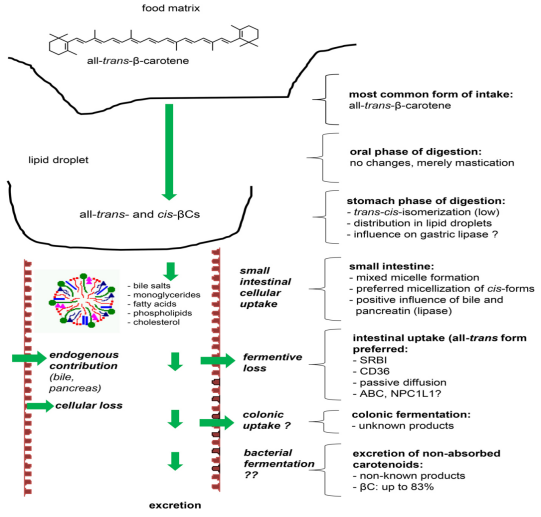Creative Proteomics can provide a high-performance LC-MS to determine the content of beta-carotene (β-carotene), which can quickly and accurately analyze the quantitative information of β-carotene and its metabolites in complex components. This method can obtain high-throughput and high-sensitivity analysis reports, so as to provide an evaluation basis for the analysis and application of β-carotene and its derivatives.
β-carotene is the most abundant carotenoid in mammalian body tissues, an important precursor of vitamin A, and the most ubiquitous and stable natural pigment in nature. β-carotene and its metabolites are key regulatory signal factors in tissue metabolism. Beta-carotene is a good food additive and nutritional supplement. It has a strong ability to capture free radicals and has anti-cancer and anti-aging effects. Under certain conditions, β-carotene can improve the body's cellular immunity, humoral immunity and non-specific immune response, enhance resistance to certain diseases, and improve health. It has been widely used in various fields such as medicine and food. By adding different levels of β-carotene to the diet, the production performance and the survival rate of offspring can be improved. When using HPLC-MS to determine the content of β-carotene, we use it as a liquid phase control after UV calibration to solve the problem of easy degradation of the reference substance. Therefore, it can also reduce the detection cost and shorten the detection time, and solve the nakedness in the solution. The β-carotene is easily degraded, which causes the detection difficulties and inaccuracy problems.
 Figure 1. Processing of β-carotene during digestion. (Bohn 2019).
Figure 1. Processing of β-carotene during digestion. (Bohn 2019).
Our operating technical process can effectively solve the difficulty of detection caused by the degradation of β-carotene, and can also eliminate the interference of other pigments, and can quickly and accurately determine the content of β-carotene in complex components. At the same time. β-carotene samples can be quickly separated and detected with good peak shape and resolution.
 Figure 2. β-Carotene analysis service workflow.
Figure 2. β-Carotene analysis service workflow.
Detection method: HPLC-MS
Mobile phase: n-hexane: methanol (40:60, V:V) as the mobile phase for elution
Elution mode: gradient elution
Injection volume: 20 ul
Detection wavelength: 450nm
Flow rate: 0.8 ml/min
Detection limit: 0.5 ug/100 g
Standard recovery rate: 92.4%-98.2%
Analysis content:
Clinical samples, no less than 30 duplicates in a single group; animal samples, no less than 9 duplicates in a single group; cell and microbial samples, no less than 5 duplicates in a single group; other such as plant samples, no less than 7 duplicates in a single group repeat.
The samples include multiple sample types such as animals, plants and microorganisms, please contact us for details.
We use HPLC-MS to detect the content of β-carotene, which can achieve high-throughput and accurate detection requirements, and provide a basis for understanding the mechanism of β-carotene and its metabolites. v-innovate Technologies has wealth of biochemical analysis experience and good reputation in the industry, which can meet your needs for customized services.
References
